Researchers from the Institute of Physics of the Czech Academy of Sciences, in cooperation with their colleagues from Stanford University, USA, University in Giessen, Germany, and the University in Hasselt, Belgium, have succeeded in developing the smallest diamond in the world [1]. A synthetically created crystal of a nanodiamond was grown from a nucleus containing 26 carbon atoms.
A study has shown that a 26-carbon atoms bulk is the smallest possible size to be used for the formation of the so-called critical nucleus of a perfect diamond crystal. The size of the nucleus is about one hundred times smaller than the width of a human hair. This discovery provides new opportunities for exploring the biological world.
The diamond is not only the hardest material but it has unique optical properties making it an ideal material for industrial purposes, such as lasers, quantum technologies or applications for biological detection. And it is for the development of cell detection where nanodiamonds may be used as nanoscopic sensors based on a nuclear magnetic resonance principle (they work on the same principle as NMR instruments in medical diagnostics but they act directly inside living cells).
For such purposes, the diamonds must be absolutely clean and their size needs to be in the order of nanometres. To achieve this, the scientists from the FZU have been looking for the smallest possible number of atoms needed for the creation of a critical diamond nucleus. This nucleus was subsequently used to grow a diamond nanocrystal with the use of methane and hydrogen atoms in a gas discharge (PECVD method – Plasma Enhanced Chemical Vapour Deposition). This method makes it possible to create crystals with 0,1 ppb clarity. This means that only one of 10 billion atoms will originate from impurities, and therefore only carbon atoms may be found in a nanodiamond crystal. Such a level of purity is necessary for the creation of a quantum sensor for the NMR detection produced using the implantation of individual nitrogen atoms into a nanodiamond crystal which forms a quantum NMR sensor in the form of the so-called NV centre (nitrogen atom fills an empty space in the crystal lattice). As a result, such crystals are pink in colour. Atomic NMR probe is able to detect e.g. protons in a close biological environment as with the large NMR devices but in nanoscale and with sensitivity billion times (1012) higher than it is achieved in a normal NMR device.
The diamond crystals were prepared by Andrew Taylor and Dr Václav Petrák from the Institute of Physics of the Czech Academy of Sciences as part of research work following on a Czech national project titled BIOKOM Nanotechnology for Society, coordinated by Prof. M. Nesládek. The findings have recently been published in the PNAS (Proceedings of the National Academy of Sciences of the United States of America) research magazine. The publication brings a new vision of the synthetic procedure of diamond production and the increase of their purity. The experimental results have also been verified by a theoretical model. These findings may be used in other areas of research, such as the production of silicon layers using plasma methods and the use as semiconductors for computer chips.
Literature
[1] Matthew A. Gebbie, Hitoshi Ishiwata, Patrick J. McQuade, Vaclav Petrak, Andrew Taylor, Christopher Freiwald, Jeremy E. Dahl, Robert M. K. Carlson, Andrey A. Fokin, Peter R. Schreiner, Zhi-Xun Shen, Milos Nesladek, and Nicholas A. Melosh, Experimental measurement of the diamond nucleation landscape reveals classical and nonclassical features, PNAS August 1, 2018.
